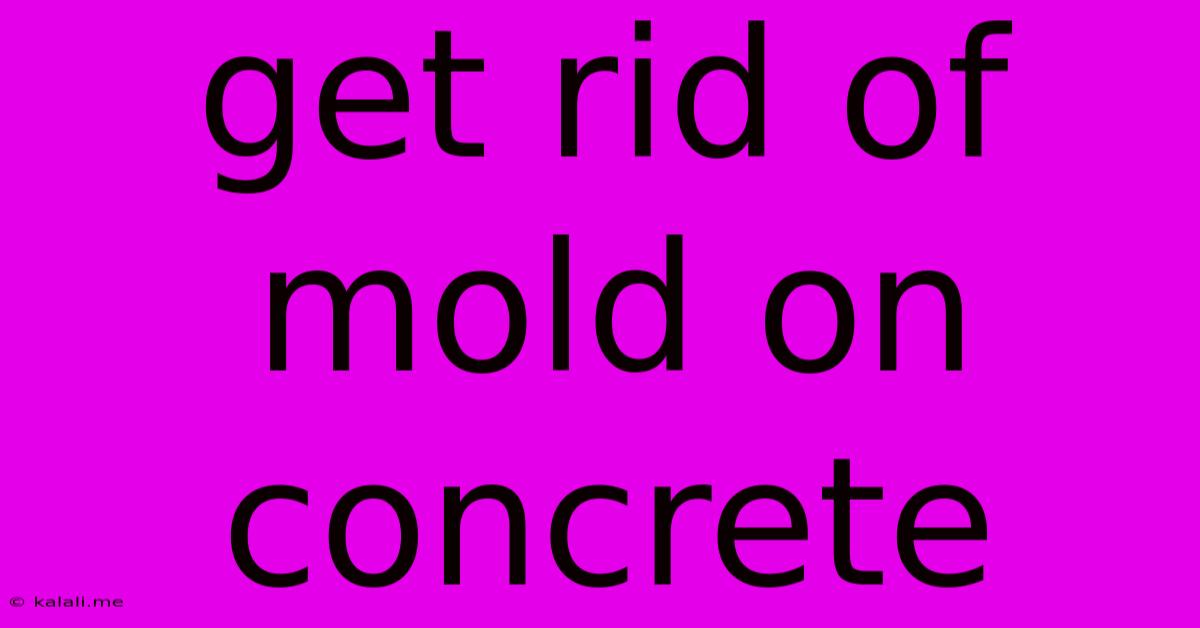Get Rid Of Mold On Concrete
Kalali
Jun 10, 2025 · 4 min read

Table of Contents
Get Rid of Mold on Concrete: A Comprehensive Guide
Mold on concrete is a common problem, unsightly and potentially harmful to your health. This guide provides a comprehensive approach to mold remediation on concrete surfaces, covering prevention, identification, and effective removal methods. Whether you're dealing with a small patch or widespread infestation, we'll walk you through the steps to safely and effectively eliminate mold and prevent future growth.
Understanding Mold Growth on Concrete
Mold thrives in damp, dark environments, and concrete, being a porous material, can readily absorb moisture. Leaks, high humidity, and poor ventilation all contribute to ideal mold-growing conditions. Identifying the source of moisture is crucial before attempting any mold removal; otherwise, you're only treating the symptom, not the cause. Common types of mold found on concrete include Cladosporium, Aspergillus, and Penicillium. These can trigger allergies and respiratory problems, highlighting the importance of prompt action.
Identifying Mold on Concrete
Before you start cleaning, accurate identification is key. Mold can manifest in various colors, including black, green, gray, white, or even orange. It often appears as fuzzy patches or slimy growths. If you're unsure about the type of mold, it’s best to consult a professional mold remediation specialist. They possess the expertise and equipment for safe and effective removal, especially when dealing with potentially toxic mold species.
Safe and Effective Mold Removal Methods
The approach to mold removal depends on the extent of the infestation. For small areas, a DIY approach might suffice, but for larger or persistent infestations, professional help is recommended.
1. Safety First:
- Protective Gear: Always wear protective gear, including gloves, a respirator mask (N95 or better), eye protection, and long sleeves and pants. Mold spores are easily airborne and can cause respiratory issues.
- Ventilation: Ensure adequate ventilation in the area. Open windows and doors to allow fresh air circulation. Using fans can also help.
2. Cleaning Solutions:
Several solutions are effective for mold removal:
- Bleach Solution: A mixture of one part bleach to ten parts water is a common and effective solution. Apply it to the affected area, allowing it to sit for about ten minutes before scrubbing with a stiff brush. Rinse thoroughly with clean water afterwards. Note: Bleach can damage some materials, so test it in an inconspicuous area first.
- White Vinegar: White vinegar is a natural and less harsh alternative to bleach. Apply it directly to the mold, let it sit for about 30 minutes, and scrub with a brush. Rinse thoroughly.
- Baking Soda: Baking soda can also help absorb moisture and neutralize odors associated with mold. Sprinkle it on the affected area, let it sit for several hours, then vacuum thoroughly.
3. Cleaning Process:
- Cleaning: Apply your chosen solution, allowing sufficient contact time.
- Scrubbing: Use a stiff brush to thoroughly scrub the moldy area.
- Rinsing: Rinse the area thoroughly with clean water to remove any cleaning solution residue.
- Drying: Ensure the area is completely dry to prevent future mold growth. Use fans or dehumidifiers to aid in the drying process.
Preventing Mold Growth on Concrete
Prevention is always better than cure. Here's how to prevent mold growth on your concrete surfaces:
- Address Moisture Issues: Repair any leaks promptly. Ensure proper drainage around your foundation.
- Ventilation: Maintain good ventilation to reduce humidity levels. Use exhaust fans in bathrooms and kitchens.
- Regular Cleaning: Regularly clean concrete surfaces to prevent mold buildup.
- Sealing: Consider sealing porous concrete surfaces to prevent moisture absorption. A sealant creates a barrier that prevents moisture from penetrating.
- Dehumidifiers: In damp environments, using dehumidifiers can significantly reduce humidity levels, inhibiting mold growth.
When to Call a Professional
If the mold infestation is extensive, you suspect toxic mold, or you're uncomfortable handling the situation yourself, it's best to contact a professional mold remediation specialist. They possess the necessary expertise, equipment, and safety protocols to safely and effectively remove mold and prevent future growth. They can also identify the underlying cause of the moisture problem and recommend appropriate solutions.
By following these steps and prioritizing prevention, you can effectively combat mold on concrete surfaces and maintain a healthy and mold-free environment. Remember, addressing the root cause of the moisture problem is crucial for long-term mold prevention.
Latest Posts
Latest Posts
-
Tube Open At Both Ends Harmonic Equation
Jun 11, 2025
-
What Should A Car Battery Voltage Be
Jun 11, 2025
-
Explicit E Symbol Copy And Paste
Jun 11, 2025
-
Unlock Bootloader Google Pixel 7 Pro
Jun 11, 2025
-
Integral Of An Absolute Value Of X
Jun 11, 2025
Related Post
Thank you for visiting our website which covers about Get Rid Of Mold On Concrete . We hope the information provided has been useful to you. Feel free to contact us if you have any questions or need further assistance. See you next time and don't miss to bookmark.